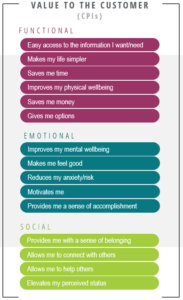We’ve heard it all before: “We owe it to our customers; we couldn’t do it without our customers; customers are our primary focus.”
While wonderful in theory, many brands’ commitment ends with their customers’ spending habits; and loyalty programs—though very clever—largely exist to sell more product, and do it more frequently.
What if, in addition to setting business KPIs around profit, growth, and operational efficiencies, companies set customer performance indicators (CPIs) focused on reaching the goals that brands can help customers achieve? Furthermore, what if that frame of reference had the power to grow the company’s bottom line?
Fortunately, 2021 has presented us with a research-validated Value Exchange model focused on understanding and delivering on customer goals—that proves it pays to invest deeper.
Marketing Technology News: MarTech Interview with Maggie Lower, Chief Marketing Officer at Hootsuite
Breaking Tradition: Shifting Success Through the Lens of Customers
Businesses that rely on standard KPIs like Customer Satisfaction (CSAT) and Net Promoter Scores (NPS) as a proxy to gauge customer sentiment operate under the illusion that “active and satisfied customers’ needs are being met.”
What these customer KPIs illustrate is the likelihood customers will purchase again down the road, in other words, the value customers are creating for the business. But where they fall short is providing an understanding of the value the business is creating for its customers beyond “value for the money.” Without digging deeper, brands risk being in tune with what customers really want and are likely to overlook opportunities for customer-centered innovation and growth.
Customer needs change over time – but universal goals remain.
What can trip up businesses is yet another common myth: it’s not scalable, if not impossible, to truly understand and act on customers’ individual needs. It makes sense, given the limitless spectrum of potential needs, and the fact that human mindsets seemingly shift with the wind.
The key is to transfer focus and look instead at what drives customers’ motivations and behaviors by evaluating what underlies and shapes those needs. We can refer to these as universal goals or core values, but the idea is the same: they represent customers’ human hardwiring, and they don’t change appreciably over time. This is the core concept of the values-based approach to understanding consumer behavior developed by Bain, futurist Andy Hines, and others; why try to track thousands of shifting needs in real-time when we can focus on a fixed, stable set of metrics?
The research in this area reveals three universal goal categories, comprising a total of 15 Customer Performance Indicators (CPIs) that help customers to function, thrive, and succeed as human beings over time. Our analysis has validated the direct relationship between CPIs and Customer Lifetime Value (CLV), with +90% accuracy. As the number of CPIs executed on for a consumer increases, growth in CLV accelerates.
Marketing Technology News: MarTech Interview with Brian Burt, Founder & Chief Executive Officer, Canopy Management
Moreover, it’s an approach at the heart of a truly customer-centric strategy that:
- Offers a window into customers’ innate motivators.
- Is easier than other metrics for employees to internalize, empathize with, and activate on.
- Complements and elevates the actionability of traditional KPIs discussed.
Changing needs, universal outcomes.
 Of course, not every CPI matters equally to every consumer. There’s a long line of research that shows clear differences between people whose universal goals tend more towards material security, and those who prioritize the pursuit of personal fulfillment and inner meaning.
Of course, not every CPI matters equally to every consumer. There’s a long line of research that shows clear differences between people whose universal goals tend more towards material security, and those who prioritize the pursuit of personal fulfillment and inner meaning.
We also expect different industries—and different brands within an industry—to have varying balances of CPI relevance. Think of a rideshare service, where functionality is likely to be paramount, compared to a wellness brand, whose customers’ emotional goals may be central; or the contrasting goals of customers shopping for economy cars vs. luxury cars.
Businesses that apply the CPI model are setting aside the differentiated experiences and expectations that customers bring in favor of understanding universal outcomes. They also understand there are different ways to deliver on CPIs, provided that their strategy centers on the universality of customer goals. Here are a few examples of CPI execution in action:
EMOTIONAL: Reduces my anxiety/risk
- The navigation app Waze has integrated a Zero-Speed Takeover function that promotes nearby dining options; it only kicks in when the vehicle has stopped, which feels less intrusive and eliminates distracted driving.
- Although it wasn’t the first DTC bed-in-a-box company, Casper popularized the trend in 2014, along with its 100-day no-risk trial to entice customers who might be nervous about investing in a mattress they couldn’t try out first; today, the extended home trial has become a standard for this growing industry.
FUNCTIONAL: Makes my life simpler
- Health insurance is notorious for its Byzantine complexity; Oscar bases its approach on reinventing the member experience, offering information and services that are refreshingly simple, easy to understand, and access.
- Discount grocer ALDI, recognized as a global leader in simplicity, has built its model on efficiency: by streamlining brands and slashing prices, ALDI eliminates endless product comparisons and cross-shopping, enabling shoppers to “conserve time and attention”
SOCIAL: Provides me with a sense of belonging
- Harley-Davidson’s brand centers on the strong connections formed by the avid Harley riders who “Live to Ride” with each other, and also creates opportunities for the company to build durable connections with its customers.
- Southwest Airlines is renowned for its positive employee culture, which in turn generates an environment and experiences that make its customers “feel celebrated as passengers”
The Takeaway
Understanding customers doesn’t have to be complex when we shift focus away from their changing needs, experiences, and expectations, and drill into a fixed set of universal goals they share—emotional, functional, and social.
This serves as the north star for both a customer-centric mindset and business ethics because it creates an understanding of what businesses offer their customers, as opposed to just the value that customers are creating for the business. It’s also a path to a better business strategy that realizes potential, finds new opportunities, and maximizes returns.
Marketing Technology News: MarTech Interview with Lorn Davis, VP of Corporate and Product Strategy at Facteus











